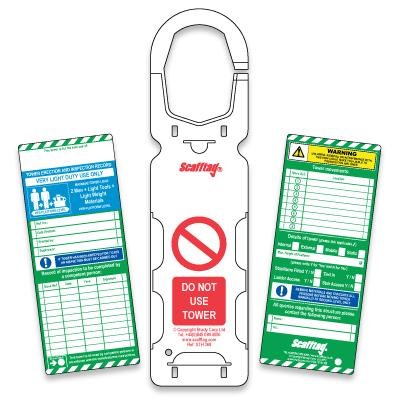Mobile Towers
Mobile towers, when used correctly, can minimise the risk of falls when working at height.

The type of mobile tower selected must be suitable for the work and any persons erecting or dismantling must be competent and follow the manufactures instruction manual.
Those using mobile towers should also be trained in the potential dangers and precautions required during use.
Mobile towers must be inspected by a competent person after first erection and at periods not exceeding 7 days thereafter.
How to Safely use Mobile Towers
Many people are injured each year when they fall from towers or when the tower overturns
The incidents that occur are mainly caused by:
- Dangerous methods of erection or dismantling – where a safe system is not being followed;
- Defects in the erected scaffold – where the tower structure is incorrectly assembled or where a platform guardrail is missing;
- Misuse of the scaffold – where a ladder is used on a tower causing it to overturn or when a person falls while the tower is being moved.
Erection and dismantling
When erecting or dismantling mobile towers it is important it is done safely.
Towers should be erected following a safe method of work, either using:
- Advance guard rail system – where temporary guard rail units are locked in place from the level below and moved up to the platform level. They are in place before the operator accesses the platform to fit the permanent guard rails.
- ‘Through-the-trap’ (3T) – involves the operator taking up a working position in the trap door of the platform, from where they can add or remove the components which act as the guard rails on the level above the platform. It is designed to ensure that the operator does not stand on an unguarded platform. See the photo below.

Stability
To maintain tower stability you must make sure:
- the tower is resting on firm, level ground with the locked castors or base plates properly supported. Never use bricks or building blocks to take the weight of any part of the tower;
- stabilisers or outriggers are installed when required by the instruction manual; and
- that a tower is never erected to a height above that recommended by the manufacturer.
Precautions and inspection
Tower scaffolds must comply with the standard of required for all types of scaffolds, eg double guardrails, toe boards, bracing and access ladder.
When the tower is purchased or hired it should arrive with all the necessary components to prevent falls and ensure stability.
Towers rely on all parts being in place to ensure adequate strength. They can collapse if sections are left out.
All towers must be inspected following assembly and then at suitable regular intervals by a competent person. In addition, if the tower is used for construction work and a person could fall 2 metres or more from the working platform, then it must be inspected following assembly and then every 7 days. Stop work if the inspection shows it is not safe to continue, and put right any faults.
The result of an inspection should be recorded and kept until the next inspection is recorded.
Although a Scafftag is not a legal requirement it is a good visual aid to allow users to see that the tower is either safe to use or unsafe.

Using and moving
Make sure everyone involved is aware of, and follows, these simple rules:
Using
Never use a tower:
- in strong winds;
- as a support for ladders, trestles or other access equipment;
- with broken or missing parts; or
- with incompatible components.
Moving
When moving a tower you should always:
- reduce the height to a maximum of 4m;
- check that there are no power lines or other obstructions overhead;
- check that the ground is firm, level and free from potholes; and
- push or pull using manual effort from the base only.
Never move a tower while people or materials are on the tower, or in windy conditions.
Note: Excerpts on mobile tower safety have been used in this blog from the HSE website. More information on mobile towers safety can be found on the HSE website below.
http://www.hse.gov.uk/construction/safetytopics/scaffold.htm
Written by Dean Oliver CMIOSH
Oliver Health and Safety Ltd
Web: www.oliverhealthandsafety.co.uk
Phone: 0800 772 3950
